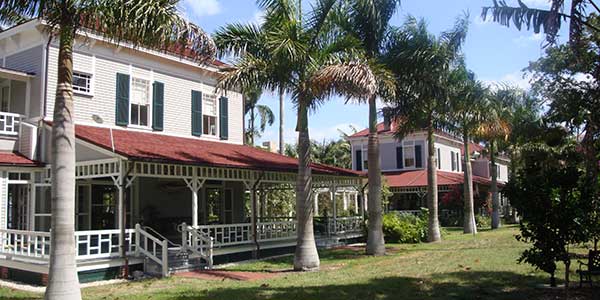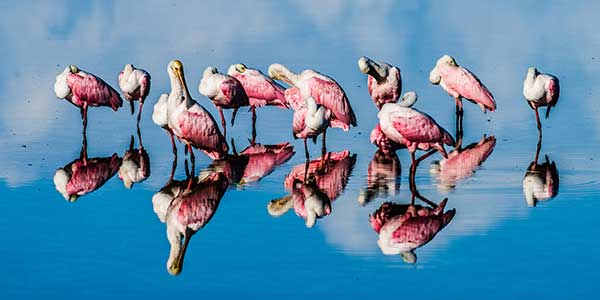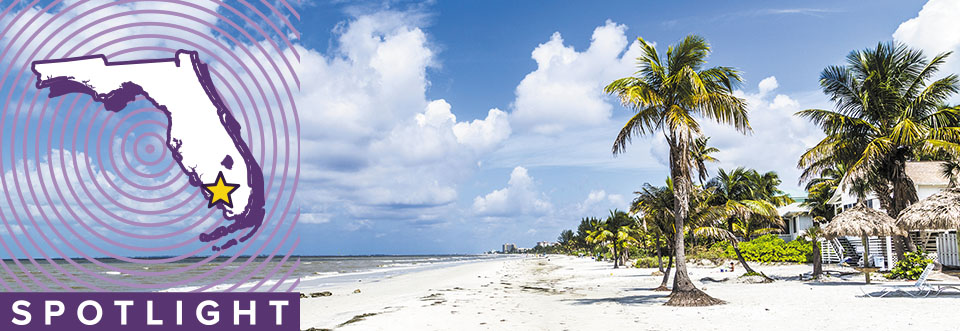Fort Myers
Find sun, sand and so much more in the City of Palms
On the surface, Fort Myers looks like just another sunny vacation destination on Florida’s Gulf Coast. But don’t be fooled. Beyond its pristine beaches, excellent fishing and plentiful shopping, you’ll experience pivotal American history, diverse culture and fun beyond your wildest dreams.
History buffs will get to dive into the lives of two of the nation’s most innovative entrepreneurs. Baseball fans are lured to the banks of the Caloosahatchee River for spring training. Animal lovers get the rare chance to come face to face with exotic wildlife at an array of nature preserves. And, of course, beachgoers will be spoiled with postcard-worthy beaches and islands. Quieter than its party-hard neighbors on the Sunshine State’s east coast, but no less intriguing, Fort Myers is an eclectic destination that offers something exciting for just about every type of traveler.
The Lives of Edison and Ford
Did you know Fort Myers’ most famous residents were inventor Thomas Edison and automobile manufacturer Henry Ford? In 1916, Ford purchased land downtown right beside Edison, his good friend and mentor.
Today, the Edison and Ford Winter Estates are open to the public and serve as museums. Spanning over 20 acres, visitors can stroll through botanical gardens and nine historic buildings. Step inside the Botanic Research Laboratory and the Estates Museum to uncover inventions and artifacts, learn about Edison’s 1,000-plus patents and see special exhibits. You’ll even find a few of Edison’s first light bulbs still burning in his lab. Check out the Museum Store, located in one of Edison’s barns.
In the garden is the first banyan tree planted in America. It was only 4 feet tall back in 1925 but now covers an acre of the property. If you’re in town in February, take part in the Edison Festival of Light, a fun-filled event celebrating Edison’s life and the great contributions he made to mankind. Activities include a car show, parades, craft booths, concerts and more.

Play Ball
Despite lacking a major league baseball team, Fort Myers still lets you experience big-league action during spring training. The Boston Red Sox and the Minnesota Twins visit the city every February and March, respectively, to practice in warm spring temperatures. You can see the Red Sox gear up for the next season at JetBlue Park. The Minnesota Twins play just 5 miles west at CenturyLink Sports Complex.
Be at One with Nature
With numerous nature preserves surrounding the city, it’s apparent Fort Myers works hard to preserve its natural environment and diverse species of wildlife. Get close to endangered Florida manatees between December and February at Manatee Park. Wanting to escape the winter cold, these large animals congregate in this natural environment to enjoy the warmer water. Examine the manatee world from multiple observation decks or paddle out in a kayak to catch a glimpse of these gentle giants.
The Calusa Nature Center and Planetarium is an environmental education organization boasting a museum, planetarium, nature trails, butterfly aviary and Audubon Aviary for injured birds of prey. Volunteer opportunities are available for snowbirds seeking to help out. As you meander through the 105-acre site, you’ll learn about southwest Florida’s natural history while seeing a variety of native animals including alligators, bald eagles, skunks, hawks, foxes and more.
Looking for shells? Take the Sanibel Causeway to Sanibel Island. Situated along the Gulf of Mexico, the island is famous for its shell-covered shores and is considered one of the best shelling destinations on the planet. Indulge in grand resorts and exquisite seafood restaurants, or unwind by taking a dip in crystal-clear waters and spreading your blanket on one of its many picture-perfect beaches.
Sanibel also is home to the J.N. “Ding” Darling National Wildlife Refuge. This massive sanctuary makes up approximately half of the island and is home to a lush mangrove forest and over 245 bird species, 35 types of mammals, and 50 breeds of reptiles and amphibians. See the most wildlife during low tide and explore the 4-mile Wildlife Drive by foot, bike, canoe, tram or vehicle. Enjoy boating and fishing in some areas of the park and participate in complimentary tours and seasonal programs at the visitor center.
On nearby Captiva Island, Barnacle Phil’s Restaurant serves up burgers, seafood and more. The eatery boasts countless dollar bills pinned to its walls. Also on Captiva Island is Turner Beach, a favorite destination of anglers with up to 50 types of fish swimming off of the island’s coastal waters.
See You at the Beach
There’s lots to do at Fort Myers Beach. Whether you want to relax on soft white sand, embark on a charter fishing tour or go on a parasailing adventure, the beach is a bustling hub of activity offering endless possibilities. The Fort Myers Beach pier is also a great spot to see anglers reel in their catch of the day, experience live performances, catch a sunset and watch dolphins frolic in the distance.
History/Imaginarium
In Fort Myers’ historic downtown, the Southwest Florida Museum of History presents a chronological sweep of regional and national history. Housed in a railroad depot served by the Atlantic Coast Line from 1924 to 1971, the museum boasts an eclectic collection that spans ancient artifacts and antiques related to Paleo Indians, Spanish explorers and the first settlers. There are also several exhibits that spotlight regional military and industrial history, including the remains of a P-39 Aircobra, a replica of an early 19-century “cracker house” and a Pullman private car. The museum hosts two-hour guided walking tours on Wednesdays at 10 a.m.
In 2017, the museum merged with the Imaginarium Science Center, which adds an additional 60 interactive exhibits that primarily explore STEM (science, technology, engineering and math) concepts. The Hall of History presents an interactive jaunt through the history of Southwest Florida, and at the mini-studio, children can try being TV weather forecasters. Natural history encounters include child-friendly Sea to See Touch Tanks and a Living Lab with turtles, a ball python, a bearded dragon and prairie dogs.
Haunted History of Fort Myers
While ghost tours have become something of a tourist trap these days, Fort Myers’ rendition of the brand is engaging, informative and suitably spine tingling — enough so that it has received national acclaim. True Tours Haunted History Tour is the brainchild of Gina Taylor, former director of the Southwest Florida Museum of History and founder of the company that aims to preserve Fort Myers’ compelling history and rejuvenate the historic river district through increased tourist traffic.
Following an extensive restoration program in the 1980s, it can take quite a leap to imagine Fort Myers’ downtown district once formed a suitable backdrop for Zombie movies, including George Romero’s “Day of the Dead.” During the 90-minute walking tour, which aims to educate rather than unnerve, professional guides enthusiastically recount chilling and meticulously researched stories of paranormal activity in several Fort Myers buildings, including the Andrew D. Gwyne Institute (a former school supposedly haunted by the ghost of a former teacher) and the Arcade Theater (a former courthouse).
Tours are peppered with humorous anecdotes relating to the district’s eclectic denizens. The outings probe the city’s untold local history that has unfolded in once-seedy back alleys and within its rambling historical buildings. Even for cynics and nonbelievers, this early evening romp through the historic district is fun and informative in equal measure.
Tours ($14) take place Wednesdays and Saturdays from 8 p.m. to 9:30 p.m. and depart from Franklin Shops at 2200 First Street.
McGregor Boulevard
There are few places in Florida that bear the imprint of entrepreneurs and visionaries quite like Fort Myers. In 1886, when entrepreneurial Ohioan Ambrose McGregor and his family came to visit Fort Myers for a fishing trip they (like many) decided to stay and cash in on what promised to be one of the most desirable resort towns in Florida. The McGregors eventually bought up the palm-lined dirt trail that is now McGregor Boulevard and transformed it into the first hard-surfaced road in Fort Myers, which would prove the catalyst for the spectacular expansion of the town during the 1920s.
Running from downtown to Summerlin Road and eventually the barrier islands, the magnificent Royal Palms that flank McGregor Boulevard soar as high as 75 feet and endow the city with its moniker, “City of Palms.” Nowadays, the pedestrian-friendly McGregor Boulevard forms the gateway to the city and is a charming ensemble of historic buildings, fine restaurants, boutiques and commercial buildings.
Butterfly Estates
In the heart of Fort Myers’ River District, the small but expertly run Butterfly Estates is home to the Florida Native Butterfly Society and comprises a number of very Zen exotic gardens, a butterfly exhibit, and nature-inspired shops and restaurants.
The main draw is the Butterfly Conservatory, a kaleidoscopic fantasia of waterfalls, a koi pond, tropical flora and hundreds of native butterflies that are bred and raised onsite (there is a butterfly release daily at 10:30 a.m.). As well as self-guided tours, there are daily, interactive tours (which can be customized) led by passionate, friendly, and knowledgeable naturalists that aim to promote conservation. At the Nature Interpretive Center, visitors can learn about the life cycle of a butterfly, from caterpillar to chrysalis to butterfly.
At the Butterfly Estates gift shop, visitors can purchase books about butterflies and habitats for keeping the colorful insects.

Four Mile Cove Ecological Preserve
Get in touch with wide-open spaces at Four Mile Cove Ecological Preserve, a 365-acre green space in Cape Coral, about 9 miles southwest of downtown Fort Myers. The preserve comprises sprawling wetlands accessible by walking trail. A long boardwalk takes visitors to viewpoints for wildlife sightings. Bring your camera to capture eagles, ibis, herons and other wading and migratory birds. An onsite visitor center provides insights into the flora and fauna located throughout the preserve. Visitors can also explore the compelling landscape with kayak rentals.
Fort Myers Homes and Gardens
Explore Fort Myers’ compelling past at the Burroughs Home & Gardens, an estate built in 1901 that hosted luminaries like the Edisons, Ford and the Firestones. Visitors can explore oaks and lush gardens, relax in a rocking chairs on the verandah and watch the nearby Caloosahatchee River roll by (the estate overlooks the waterway). The Georgia Revival mansion is one of the few homes of its kind still standing in Fort Myers. The house’s authentic furniture and period antiques take visitors back in time.
Everglades Family Adventure
A tour of Everglades National Park is informative and fun in equal measure. One of the most popular family excursions from Fort Myers, the Everglades constitute the largest subtropical ecosystem in the U.S. and provide refuge to a rich array of flora and fauna.
A number of outfitters and naturalist guides are based in Fort Myers and provide excellent half- and full-day excursions. Some tours include airboat rides through the Everglades followed by an alligator show and a visit to an animal sanctuary. Others feature specialized tours that cater to travelers looking for both adventure and a more intimate appreciation of the park’s flamboyant biodiversity.
Active families can enjoy close encounters with the resident wildlife as they kayak through mangroves and swamps that teem with wildlife, including herons, egrets, gallinules, spoonbills and alligators. Budding botanists can embark on an intimate guided waking tour amongst cypress hammocks and wetlands on a quest for illusive orchids.
For More Information
The Beaches of Fort Myers and Sanibel
800-237-6444
www.fortmyers-sanibel.com
Florida Tourism
888-735-2872
www.visitflorida.com






